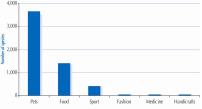
Human uses have been recorded for 45% of the world’s nearly 10,000 bird species. Over a third of bird species are kept as pets and around one in seven is hunted for food. It is difficult to know how many individual birds are used, although it is estimated that between half a billion and one billion songbirds are hunted each year in Europe alone, for sport and food.

Almost half of all bird species (4,561 bird species; 46%) have been recorded as used for one purpose or another by humans, and the real total is probably higher, as it is more difficult to find documented records of species hunted for food. Excluding the small proportion of these records that relate to historical uses, or those for which only a trivial number of individuals are involved, the number of species currently exploited is 4,173 (representing 42.3% of extant species). Today, 37% of all extant species (9,856) are used as pets, 14% are hunted for food and 4% are hunted for sport (Butchart 2008).
Less common usages include, for example, harvesting feathers for bedding (e.g. Common Eider Somateria mollissima: Kear 2005) and ornaments (e.g. bird of paradise plumes used in tribal head-dresses: Frith and Beehler 1998), oil for fuel (e.g. Oilbird Steatornis caripensis: del Hoyo et al. 1999), skin for leather (e.g. Greater Rhea Rhea americana: del Hoyo et al. 1992), traditional medicine (e.g. Hispaniolan Lizard-cuckoo Coccyzus longirostris is eaten to ‘cure’ indigestion: del Hoyo et al. 1997) and ornamentation (e.g. skulls of Papuan Hornbill are worn for decoration: Kemp 1995).
The number of individual birds used each year is very difficult to quantify. The total number sold each year in international trade at the start of the 1990s was estimated to be c.2–5 million, and the number of individual birds taken each year for international trade at that time may have been up to 10 million—since as many as half the birds could have died before they reached a dealer (Mulliken et al. 1992). The estimated numbers taken and sold in domestic trade is not known, but may well be on a similar scale (Mulliken et al. 1992). In terms of hunting for sport and food, Hirschfeld and Heyd (2005) estimated that at least 102 million individuals of the 82 bird species listed on Annex II of the EU Birds directive were killed in the EU during 2001–2003, while Magnin (1991) estimated that 0.5–1 billion songbirds are killed each year in Europe, with 100–150 million a year killed in Italy alone. Recent estimates in the Mediterranean suggest 11-36 million individual birds per year may be killed/taken illegally in the region, many of which are on migration (Brochet et al. 2016).
Hence a substantial proportion of species, and substantial numbers of individuals, are used by humans for a wide diversity of purposes. This finding illustrates how intimately connected are birds and people.
Related Case Studies in other sections
Related Species
References
Compiled: 2008 Last updated: 2016
Recommended Citation:
BirdLife International (2016)
Nearly half of all bird species are used directly by people.
Downloaded from https://datazone.birdlife.org/sowb/casestudy/nearly-half-of-all-bird-species-are-used-directly-by-people on 22/12/2024